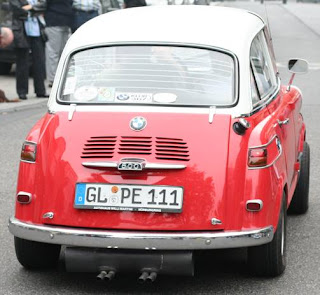BMW 600
The BMW 600 is a four-seat microcar produced by BMW from mid-1957 until November 1959. Partially based on the BMW Isetta two-seater, it was BMW's first postwar four seat economy car. It was not a sales success, but it began the design process for its more successful successor, the BMW 700.
|
Manufacturer
|
BMW
|
|
Production
|
1957–1959 (34,813 built)
|
|
Predecessor
|
|
|
Successor
|
|
|
Layout
|
RR layout
|
|
Engine
|
582 cc flat twin
|
|
Transmission
|
4-speed manual all-synchromesh
|
|
Wheelbase
|
1,700 mm (67.0 in)
|
|
Length
|
2,900 mm (110.0 in)
|
|
Width
|
1,400 mm (55.0 in)
|
|
Height
|
1,375 mm (54.1 in)
|
|
Curb weight
|
515 kg (1,140 lb) dry weight
|
|
Related
|
|
|
Designer(s)
|
Willy Black
|
Concept, design and engineering
 |
| Right 3/4 view, with front door open and side door in view |
 |
| BMW 600 controls |
As a result, the 600 used the front suspension and front door of the Isetta. The need to carry four people required a longer frame, a different rear suspension, and a larger engine. A new perimeter frame was designed, using box section side members and straight tube crossmembers. The rear suspension was an independent semi trailing arm design; this was the first time BMW had used this system. The chassis had a wheelbase of 1,700 millimetres (67 in), a front track of 1,220 millimetres (48 in), and a rear track of 1,160 millimetres (46 in).
The 600 was powered by the 582 cc (35.5 cu in) flat-twin engine from the R67 motorcycle/sidecar combination. This engine, which delivered 19.5 horsepower (14.5 kW) at 4,500 revolutions per minute, was mounted behind the rear wheels. A four-speed manual gearbox was standard, while a Saxomat semi-automatic transmission was available. The 600 had a top speed of approximately 100 km/h.
Access to the rear seats was by a conventional door on the right side of the vehicle.
The 600 was powered by the 582 cc (35.5 cu in) flat-twin engine from the R67 motorcycle/sidecar combination. This engine, which delivered 19.5 horsepower (14.5 kW) at 4,500 revolutions per minute, was mounted behind the rear wheels. A four-speed manual gearbox was standard, while a Saxomat semi-automatic transmission was available. The 600 had a top speed of approximately 100 km/h.
Access to the rear seats was by a conventional door on the right side of the vehicle.
Reception
 |
| The Isetta image hurt the sales of this larger, more upscale car |
Legacy
 |
| Rear view of the 600 |
The 600 played a direct role in the design of its successor, the BMW 700. Wolfgang Denzel, the distributor of BMW cars in Austria, commissioned Giovanni Michelotti to prepare concept sketches based on a lengthened BMW 600 chassis. Denzel presented the concept, a 2-door coupe with a slanted roof, to BMW's management. The concept was generally well received, but objections were raised about the limited passenger space. BMW decided to produce two versions, the coupe, and a 2-door sedan with a taller, longer roof.
Another legacy of the 600 was its independent semi-trailing arm rear suspension. This was BMW's first use of this suspension system and, with the exception of the BMW M1, it was used on every BMW production automobile until the 1990s. It was eventually supplanted by the "Z-axle" multi-link suspension introduced with the BMW Z1 in 1988. The last BMW cars with semi-trailing arm suspension were the BMW Compact and the BMW Z3.
Another legacy of the 600 was its independent semi-trailing arm rear suspension. This was BMW's first use of this suspension system and, with the exception of the BMW M1, it was used on every BMW production automobile until the 1990s. It was eventually supplanted by the "Z-axle" multi-link suspension introduced with the BMW Z1 in 1988. The last BMW cars with semi-trailing arm suspension were the BMW Compact and the BMW Z3.










Anything about the new myvi ?
ReplyDelete